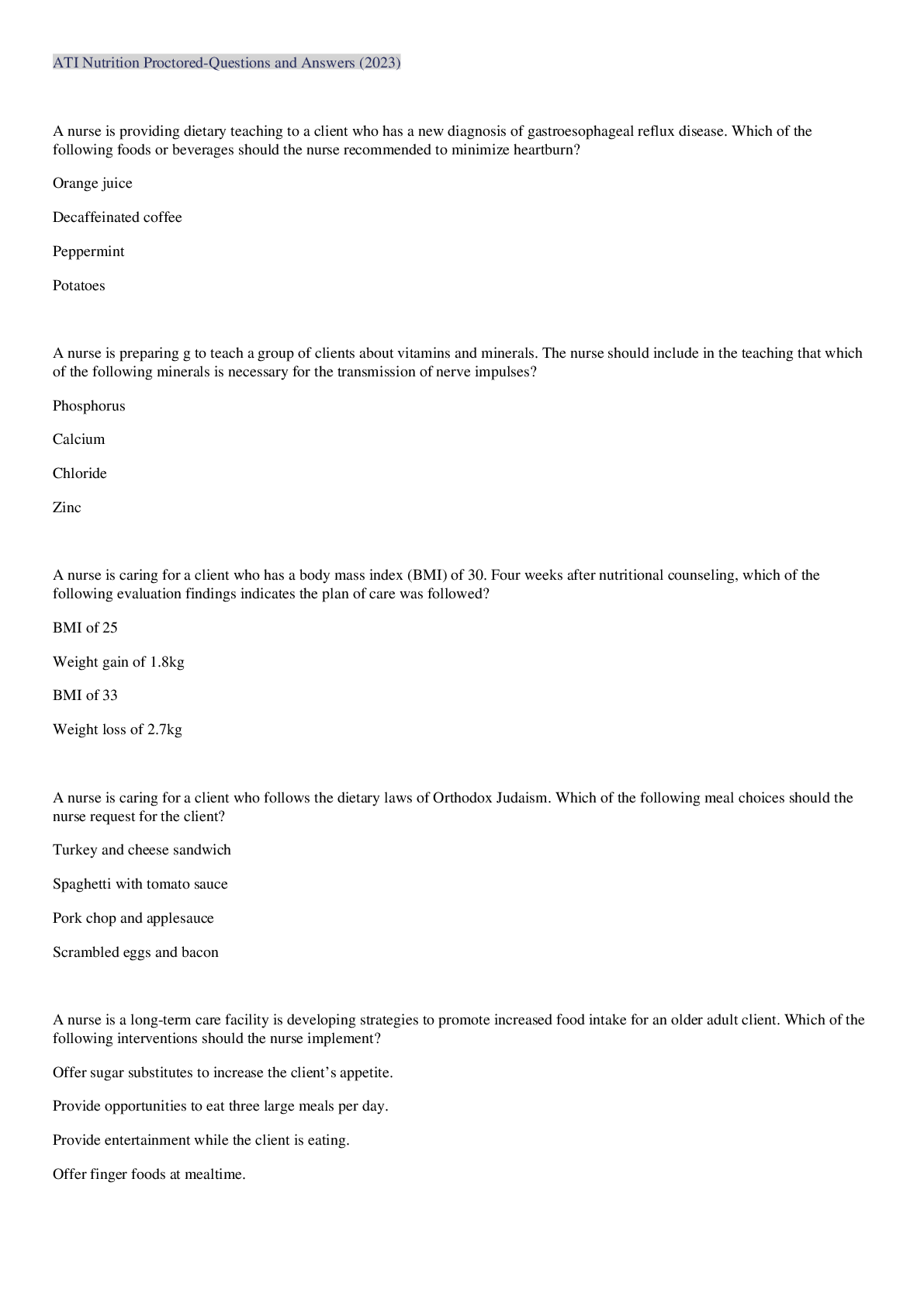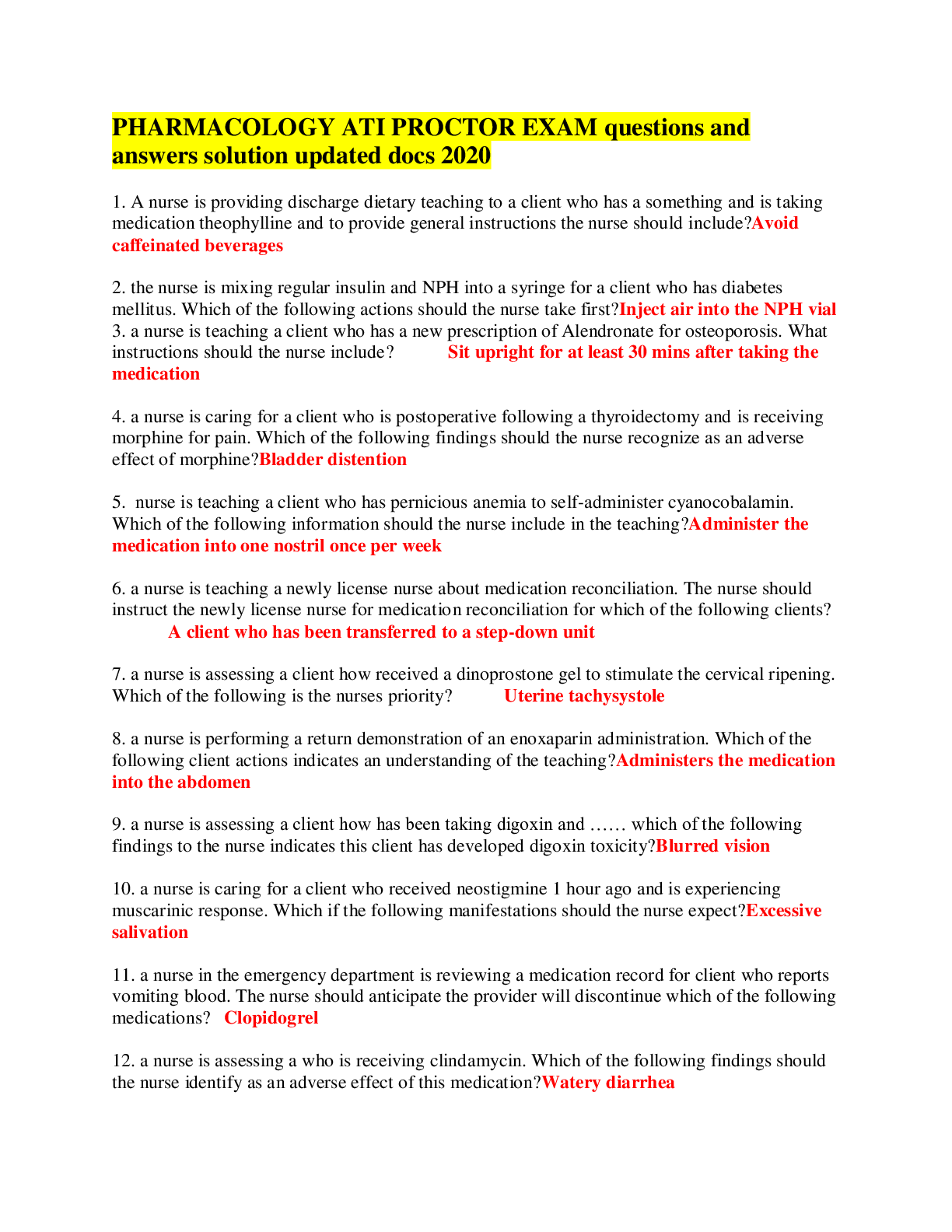Keiser University: NUR 3525 ATI Questions and Answers _Latest,100% CORRECT
Document Content and Description Below
Keiser University: NUR 3525 ATI Questions and Answers _Latest 1. A nurse is caring for a client who had a total hip arthroplasty. Which of the following actions should the nurse take to prevent dis... location? a. Encourage the client to lean forward when attempting to stand. b. Elevate the knees higher than the hips when sitting c. Place to bed pillows between the legs when in bed d. Remove the wedge device when turning 2. A nurse suspects that a client who has diabetes mellitus is experiencing hypoglycemia. Which of the following assessment findings suspicion? a. Increased urine output b. Kussmaul respiration c. Acetone breath d. Cool, clammy skin 3. A nurse is providing discharge teaching for a client who has asthma and a new prescription for a metered dose inhaler which of the following client statements indicates an understanding of the teaching? a. “I should clean the cap of the inhaler once per week” b. “I should wait 15 seconds between puffs” c. “I should shake the inhaler before I use it” d. “I should inhale the medication quickly” 4. A nurse is planning care for an older adult client who has Meniere’s disease. Which of the following intervention should the nurse include in the plan? a. Limit the clients fluid intake to 1500 mL/day b. Encourage the client to change position slowly c. Perform range of motion exercises to the clients neck every 4 hr d. Administer aspirin if the client reports a headache 5. Nurse is caring for a client who is experiencing a hypertensive crisis. Which of the following actions should the nurse take? a. Initiate an IV dopamine infusion b. Place the client supine c. Begin an IV bolus of lactated ringer’s d. Perform neurological assessment 6. The nurse is caring for a client who has a lower extremity fracture and a prescription for crutches. Which of the following client statements indicate that the client is adapting to their rule change? a. “These crutches will make it impossible to care for my child” b. “I will need to have my partner take over shopping for groceries and cooking the meals for us” c. “I feel bad that I have to ask my partner to keep the house clean” d. “It’s going to be difficult to tell my parents I can’t take them to their appointments anymore.” 7. Nurse is caring for an older adult client who has dementia. Which of the following question should the nurse ask to assess thinking? a. “Can you count backwards from 100 and intervals of 7?” b. “Can you tell me the state where you were born?” c. “What is meant by the saying don’t be around a brush?” d. “What do you understand about your condition?” a. Apply an ice pack to the clients knee. b. Perform range of motion exercises to the clients knee c. Please pillows under the clients knee d. Gently massage the area around the clients incision 9. A nurse is caring for a client who has just returned from surgery with an external fixator to the left tibia which of the following assessment findings require immediate intervention by the nurse? a. The client reports a pain level of seven on a scale from 0 to 10 at the operative site b. The client has an oral temperature of 38.3°C (100.9°F) c. The client has 100 mL blood in the closed section drain d. Client capillary refill in the left toe is 6 seconds 10. Nurse is caring for a client who has hypertension, cool and clammy skin, tachycardia, and tachypnea. In which position should the nurse place the client? a. Reversed Trendelenburg b. High-Fowler’s c. Side-lying d. Feet elevated 11. A nurse is caring for a client in the emergency department who experience a full thickness burn injury to the lower torso one hour ago which of the following findings should the nurse expect? a. Decreased respiratory rate b. Hypotension c. Bradycardia d. Urinary diuresis 12. A nurse is caring for a client who is postoperative and develops respiratory depression after receiving morphine for pain which the following medication should the nurse expect the provider to prescribe? a. Calcium gluconate b. Naloxone c. Flumazenil d. Diphenhydramine 13. A nurse is caring for a client who has infective endocarditis. For which of the following complications should the nurse monitor? a. Bradycardia b. Cardiac tamponade c. Heart failure d. Pericardial friction rub 14. A nurse is planning care for a plant to have for thickness burns on the lower extremities. Which of the following intervention should the nurse include? a. Limit visitation time for the clients children to 40 minutes per day b. Provide a diet of fresh fruits and vegetables for the client c. Clean the equipment in the clients room once per week d. Apply new gloves when alternating between wound care sites 15. A nurse is assessing a client admitted with peripheral vascular disease which of the following findings indicates a venous vascular disorder? a. An ulcer on the tip of a toe b. Hair loss just go to the clients calves c. Edema of the ankle d. Leg pain at rest 16. The nurse is caring for a client who has a sealed radiation implant. Which of the following actions should the nurse take? a. Limit family member visits to 30 minutes per day b. Removed soiled linens from the room after each change apply a second pair of gloves before touching the client’s implant if it dislodges c. Apply a second pair of gloves before touching the clients implant if it dislodges Give the dosimeter badge to the oncoming nurse at the end of the shift 17. A nurse is assessing a client following the insertion of a central venous catheter. Which of the following findings a. Distended neck veins b. Diminished breath sounds c. Irregular heart rate d. Itching over the incision 18. A nurse is administering potassium chloride via IV infusion to a client who has severe hypokalemia. Which of the following actions should the nurse take? a. Check the infusion site at least every 4 hr b. Start the infusion at 30 mEq/hr c. Monitor the client for adequate urine output d. Assess the client for a positive Chvostek’s sign 19. The nurse is planning care for a client who has left-sided Hemiplegia following a stroke. Which of the following actions should the nurse include in the plan of care? a. Provide the client with a short handled reacher b. Position the bedside table on the clients left side c. Place a plate guard on the clients meal tray d. Remind the client to use a cane on his left side while ambulating 20. A nurse is preparing to administer two units of packed RBCs to a client. Which of the following actions should the nurse take? a. Transfuse each unit of blood over 5 hr b. Administer the blood through a 22-gauge intravenous catheter c. Change the IV tubing after each unit of blood transfused d. Prime to being with 0.9% sodium chloride 21. A nurse is caring for a client who is postoperative following an endoscopy with moderate (conscious)sedation. Which of the following findings is the nurses priority. a. Temperature b. Level of pain c. Warmth of extremities d. Gag reflex 22. A nurse is caring for a client who has just undergone a total laryngectomy. Which of the following findings is the nurse’s priority for this intervention? a. IV infiltration b. Tachypnea c. Blood tinged secretions d. Fever 23. A nurse is admitting a client to the emergency department after a gunshot wound to the abdomen. Which of the following actions should the nurse take to help prevent the onset of acute kidney failure? a. Insert a urinary catheter b. Prepare the client for an intravenous pyelogram c. Initiate beta blocker therapy d. Administer IV fluids to a client 24. Charge nurse received a call from the house supervisor requesting room assignments for four new clients. Based on the admission which of the following clients requires a private room? 25. A nurse is caring for a client who has bounding pulses, crackles on auscultation, and pink frothy secretions when receiving s. The nurse should recognize these assessment findings as indicating which of the following? a. Fluid volume excess b. Aspiration c. Increase cardiac output d. Plural effusion 26. A nurse in an emergency department is preparing a client for emergency surgery. The clients blood alcohol level is 180mg/dL. Which of the following actions is the nurses priority? a. Apply antiembolic stockings b. Insert an indwelling urinary catheter c. Insert an NG tube d. Obtain consent for surgery 27. A nurse is completing an assessment of an older adult client and notes reddened areas of over the bony prominences, but the client skin is intact. Which of the following interventions should the nurse include in the plan of care? a. Support bony prominences with pillows b. Apply an occlusive dressing c. Massage the reddened areas three times daily d. Turn and reposition the client every 4 hr 28. A nurse is caring for a client who is receiving continuous bladder irrigation following a transurethral resection of the prostate. The bladder spasms and the nurse observes decreased urinary output. Which of the following actions should the nurse take? a. Administer ibuprofen 400 mg for pain relief b. Decrease traction on the catheter c. Flush the catheter manually with 0.9% sodium chloride d. Remove the indwelling urinary catheter 29. A nurse is providing teaching to a client and his partner about performing peritoneal dialysis at home. When discussing peritoneal dialysis which of the following manifestations should the nurse identify as the earliest indication of this complication? a. Cloudy effluent b. Generalized abdominal pain c. Increased heart rate d. Fever 30. Nurse is caring for a client admitted with a skull fracture. Which of the following assessment findings should be of g nurse? a. WBC count changes from 9000 to 16,000/mm3 b. Pulse pressure changes from 30 to 20 mm Hg c. Glasgow coma scale score changes from 14 to 9 d. Bilateral people diameter changes from 4 to 2 mm 31. A nurse finds a client in bed, unresponsive and breathing. Which of the following actions should the nurse take first? a. Apply a blood pressure cuff b. Establish an IV access c. Palpate for the clients carotid pulse d. Initiate cardiac monitoring for the client 32. Nurse is caring for a client who is receiving a blood transfusion. The nurse observes that the client has bouncing peripheral pulses and distended of jugular veins. The nurse should anticipate administering which of the following prescribes medication? a. Pantoprazole b. Diphenhydramine c. Furosemide d. Acetaminophen 33. Nurse is caring for a client who is receiving total parenteral nutrition TPN. The current infusion is almost complete and the new solution is not available. Which of the following actions should the nurse take? a. Infuse dextrose 10% in water b. Disconnect and flush the IV access line c. Decrease the TPN infusion rate d. Administer lactated ringer’s through a peripheral IV site 34. A nurse is planning care for a client who has a central venous access device for intermittent infusion. Which of the following actions should the nurse include in the plan of care? a. Use clean technique when changing the dressing b. Flush the catheter using 10-mL syringe c. Change the dressing every 24 hr d. Cleanse the site with providone iodine 35. A nurse is reviewing the medical record of a client who is scheduled for a CT scan with contrast media. Which of the following would the nurse instruct the client to withhold for 48 hours following the procedure? a. Clopidogrel b. Metformin c. Carvedilol d. Furosemide 36. A nurse is assessing a client who has right sided heart failure. Which of the following assessment findings should the nurse expect? a. S3/S4 galloping heart sounds b. Pitting edema c. Poor skin turgor d. Oliguria 37. A nurse on an oncology unit is caring for a client who is receiving internal radiation therapy. Which of the following actions should the nurse instruct the patient? a. Leave the door to the clients room open b. Allow visitors to hold the clients hand c. Wear a lead apron when providing client care d. Place the dosimeter film badge on the clients floor 38. A community health nurse is reviewing home care instructions with an older adult client who has a new diagnosis of heart failure which of the following is a priority topic for the nurse to review with the client? a. Changes in weight b. Fluid intake record c. Daily exercise routine d. Daily sodium restrictions 39. The nurse is preparing to administer furosemide to a client who has acute heart failure. Which of the following laboratory results identify as a contra indication for receiving the medication? a. BUN 18 mg/dL b. Sodium 136 mEq/L c. Potassium 3.2 mEq/L d. Creatinine 0.8 mg/dL 40. A nurse in the clinic is providing preventative teaching to an older adult client during a well visit. The nurse should instruct the client that which of the following immunizations are recommended for healthy adults after the age of 60? (select all that apply) a. Herpes zoster b. Meningococcal c. Pneumococcal polysaccharide d. Influenza e. Human papilloma virus 41. A nurse in an emergency department is reviewing a clients ECG reading. Which of the following findings should the nurse indentify that the client has first-degree heart block? a. No correlation between P and QRS waves b. Nondiscernible P waves c. More P waves then QRS complexes d. Prolonged PR intervals 42. A nurse is caring for a client who has an acute kidney injury. Which of the following actions should the nurse take? a. Monitor the client for an increase in peripheral edema b. Obtain the client weight every other day c. Limit the clients daily protein intake to 30 g per day d. Administer Lactated ringers IV bolus to the client 43. A nurse in a providers office is teaching a client about the self management of Gerd. Which of the following instruction should the nurse include? a. “Sleep with the head of your bed elevated 6 inches” b. “lie down for 30 minutes after each meal” c. “eat a light meal one hour before bedtime” d. “increase your caloric intake by 250 calories per day” 44. A nurse is preparing to perform ocular irrigation for a client following a chemical splash to the eye. Which of the following should the nurse plan to take first? a. Administer proparacaine eye drops into the affected eye b. Collect information about the irritant that caused the injury c. Instill 0.9% sodium chloride solution into the affected eye d. Placed a strip of pH paper onto the cul-de-sac of the affected eye 45. A nurse is planning care for a client who has syndrome of inappropriate antidiuretic hormone. Which of the following instruction should the nurse include? a. Check for increase urine specific gravity b. Encourage a fluid intake of 3000 mL daily c. Monitor for elevated serum sodium levels d. Test for increase deep tendon reflexes 46. A nurse is planning care for a client who has status epilepticus. Which of the following interventions is the nurses priority to include? a. turn the client to the lateral position during seizure activity b. Provided the client oxygen at 6 L/min using a nasal cannula c. Administer diazepam intravenously to the client d. Administer phenytoin IV bolus to the client a. Do not elevate the arm above the level of the heart b. Use a 10-mL syringe to flush the line c. Change the catheter dressing daily d. Clean the insertion site using mL of hydrogen peroxide [Show More]
Last updated: 1 year ago
Preview 1 out of 19 pages
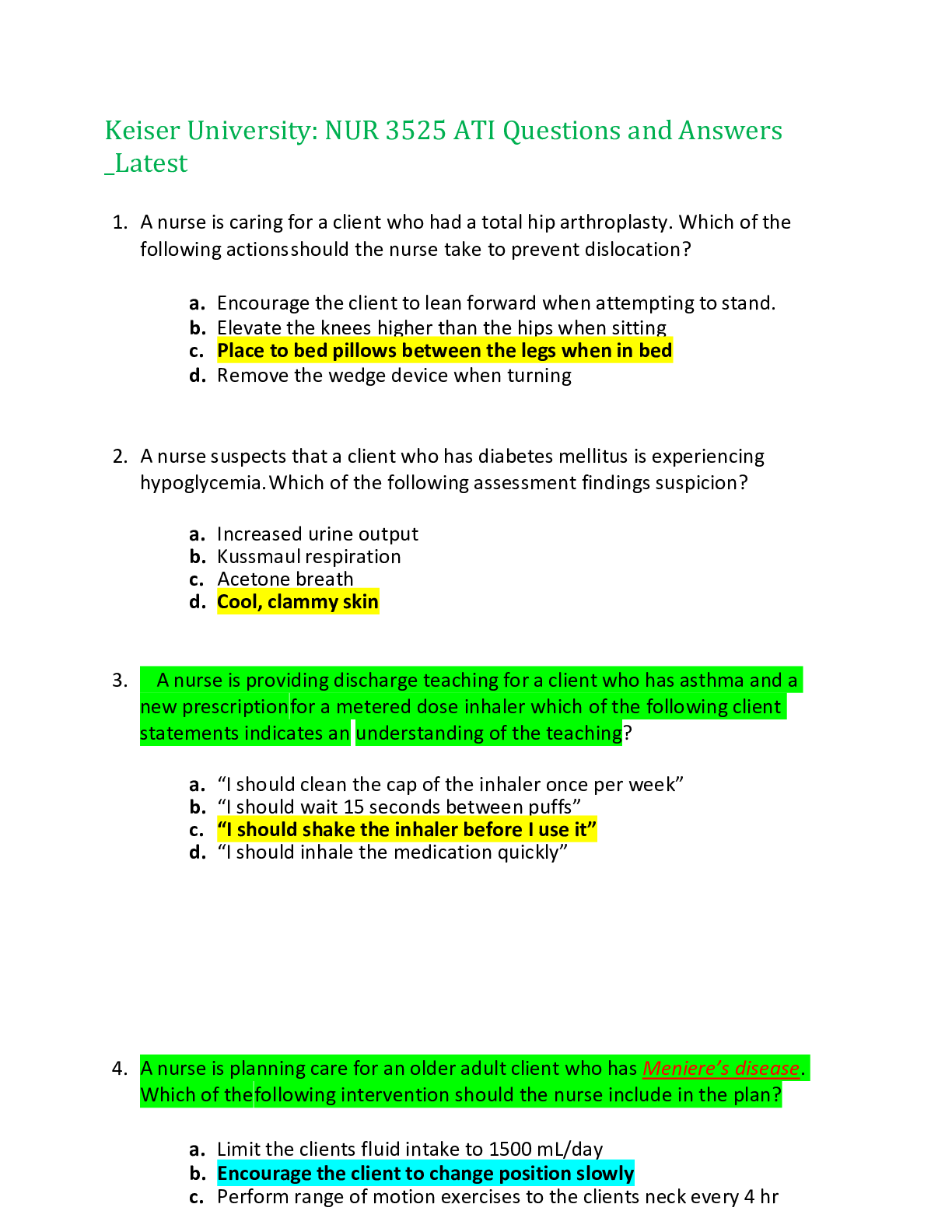
Reviews( 0 )
Document information
Connected school, study & course
About the document
Uploaded On
Mar 21, 2022
Number of pages
19
Written in
Additional information
This document has been written for:
Uploaded
Mar 21, 2022
Downloads
0
Views
45

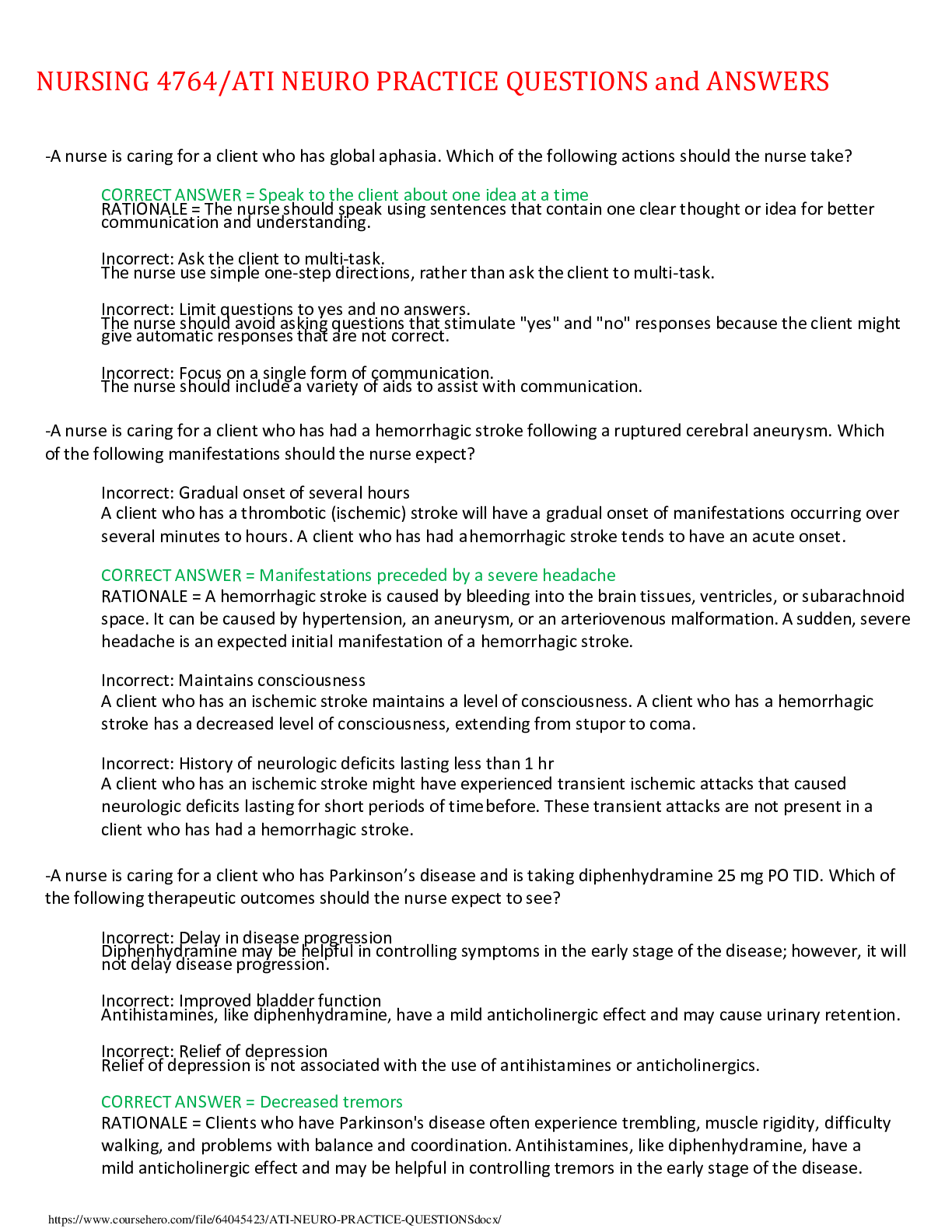
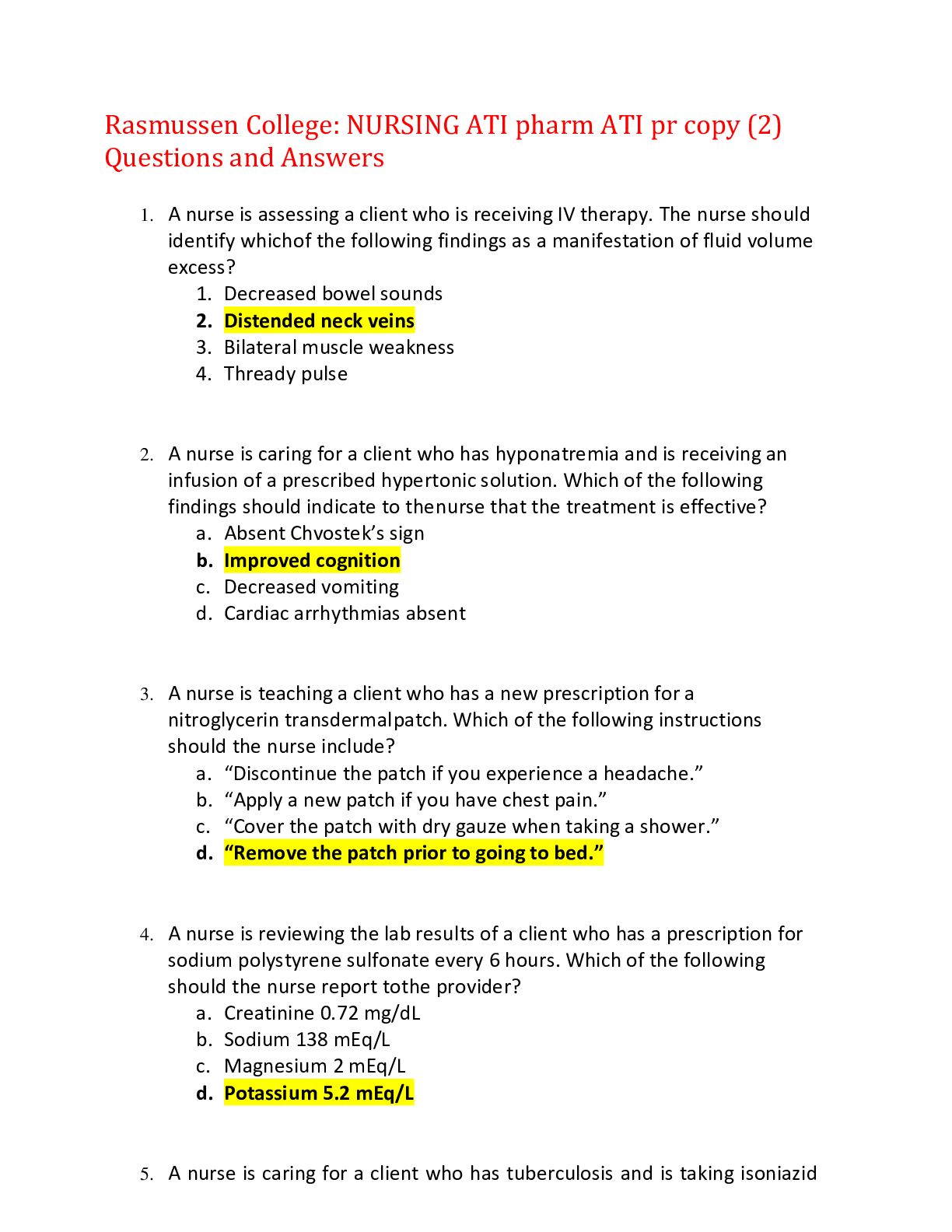
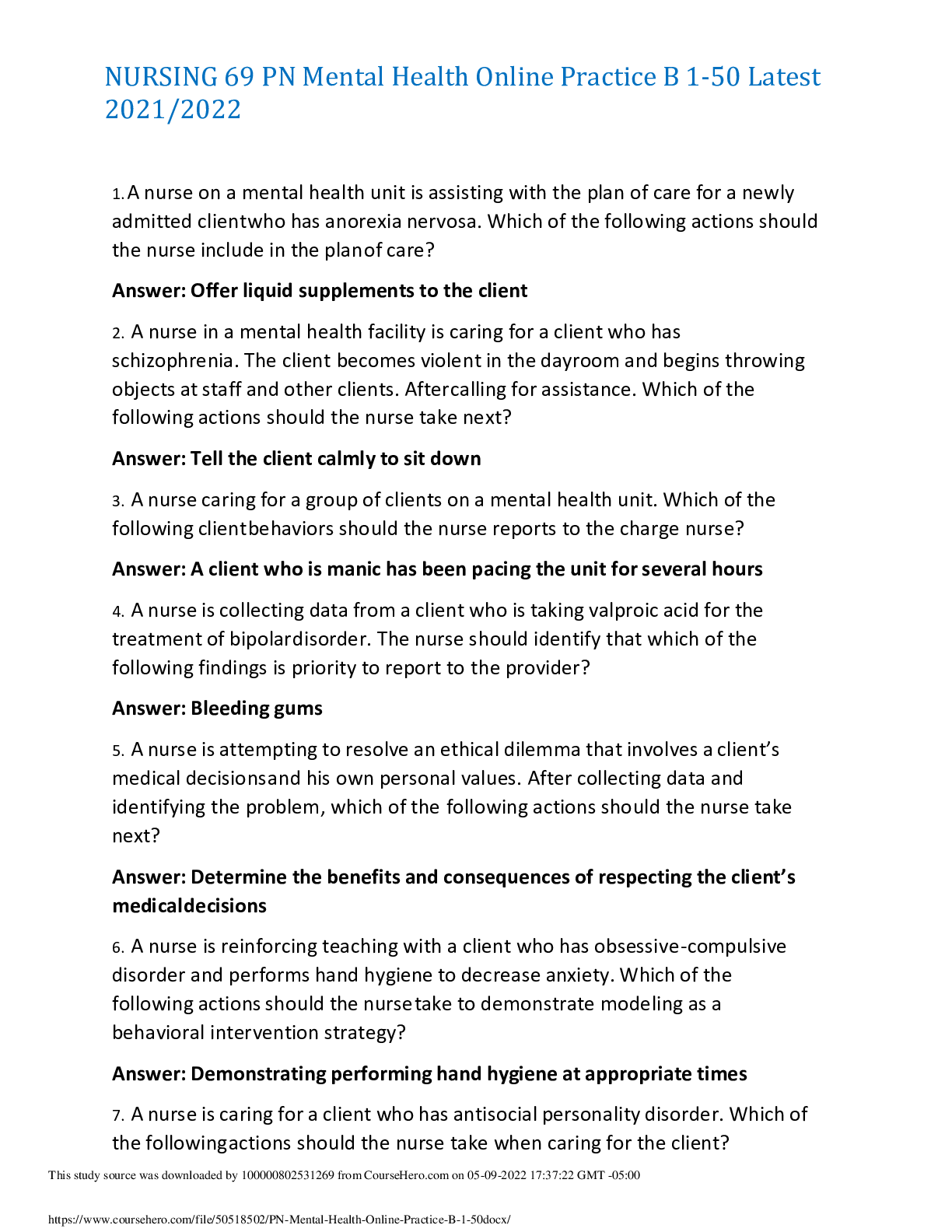

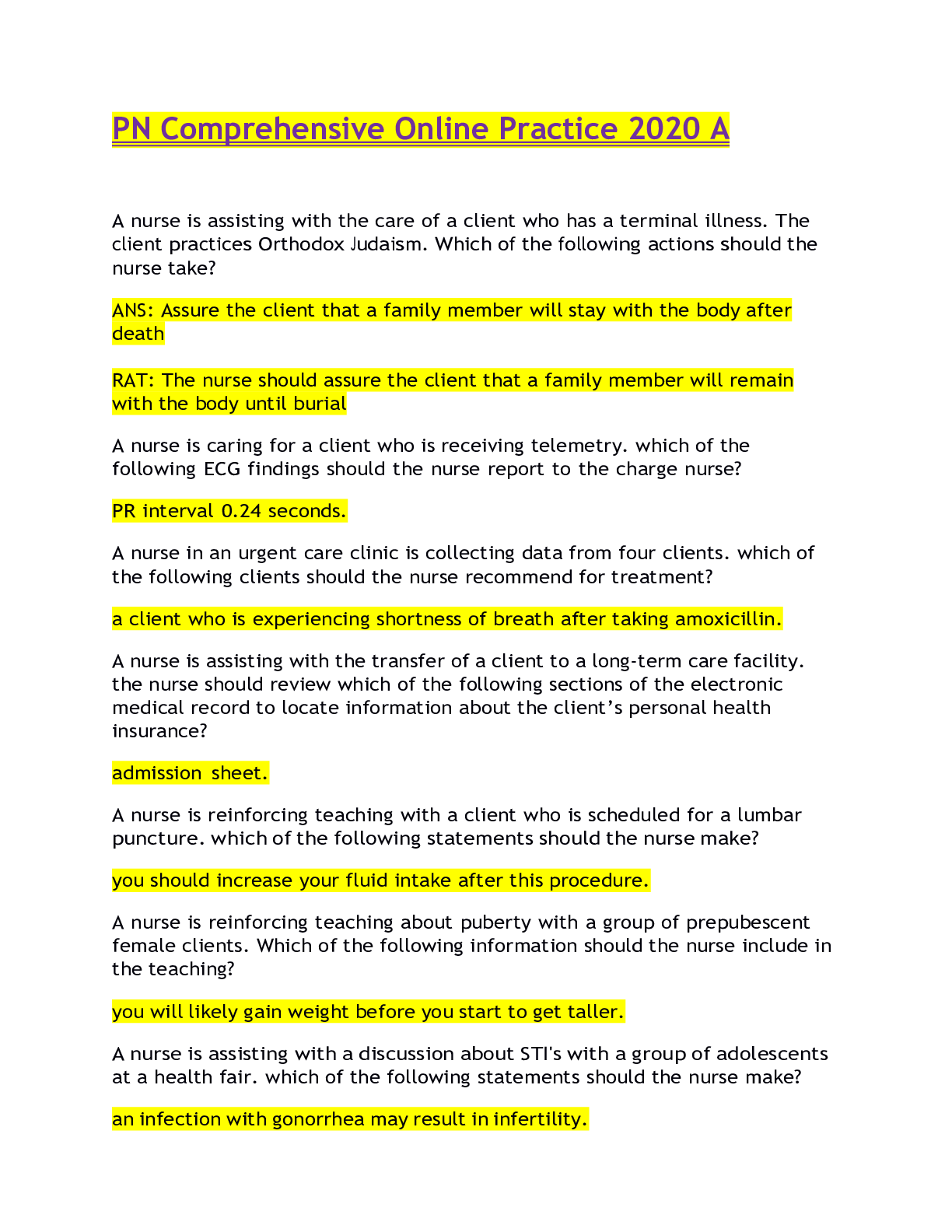
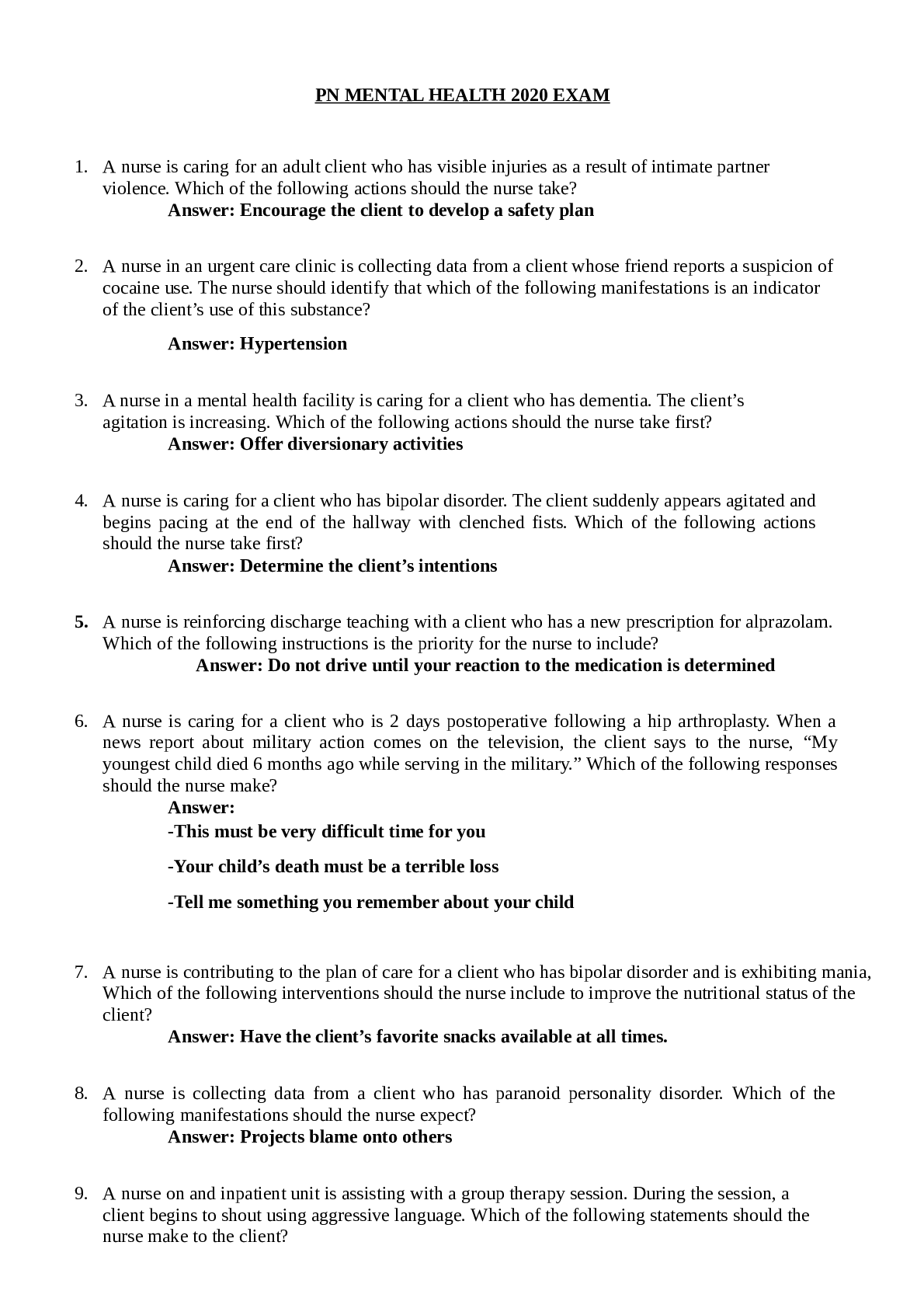


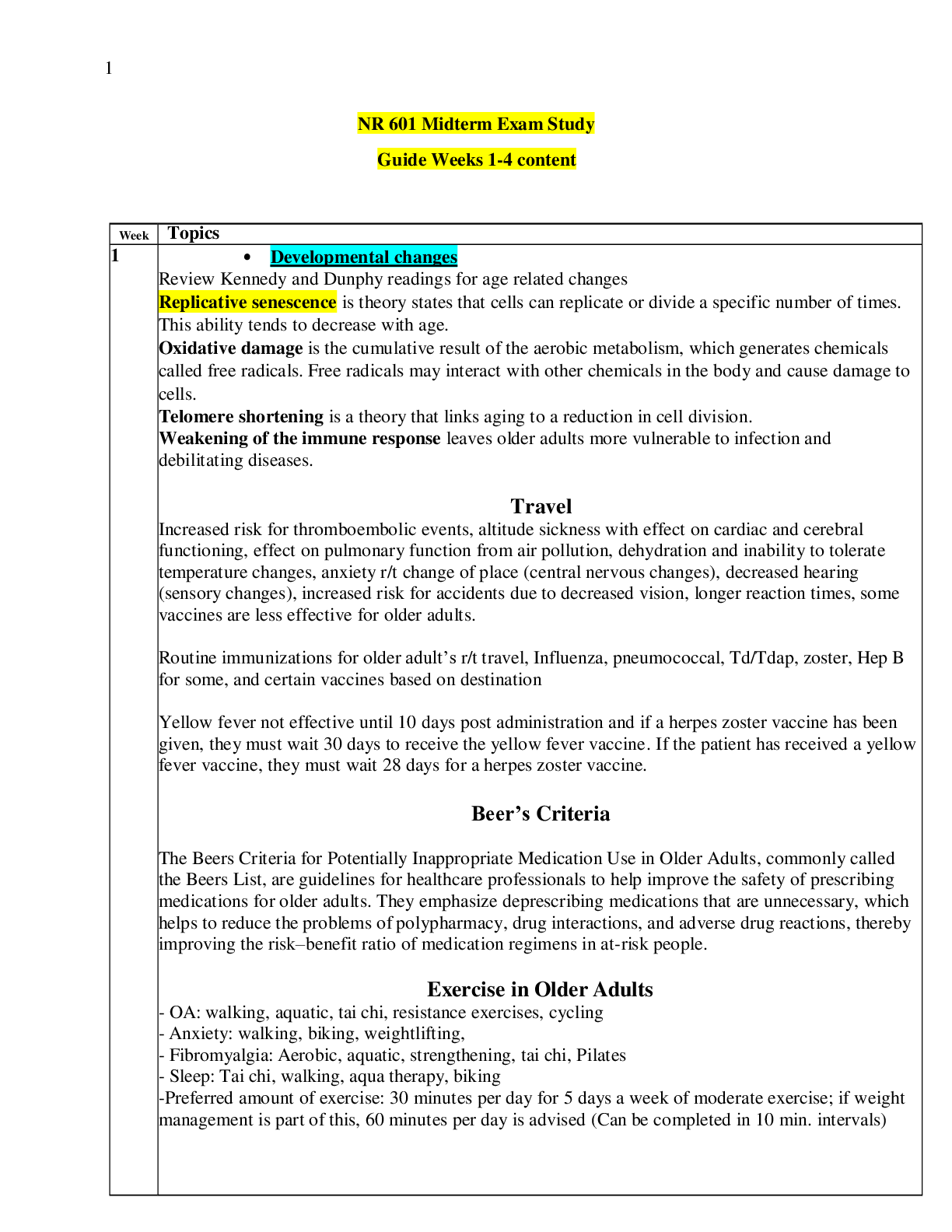
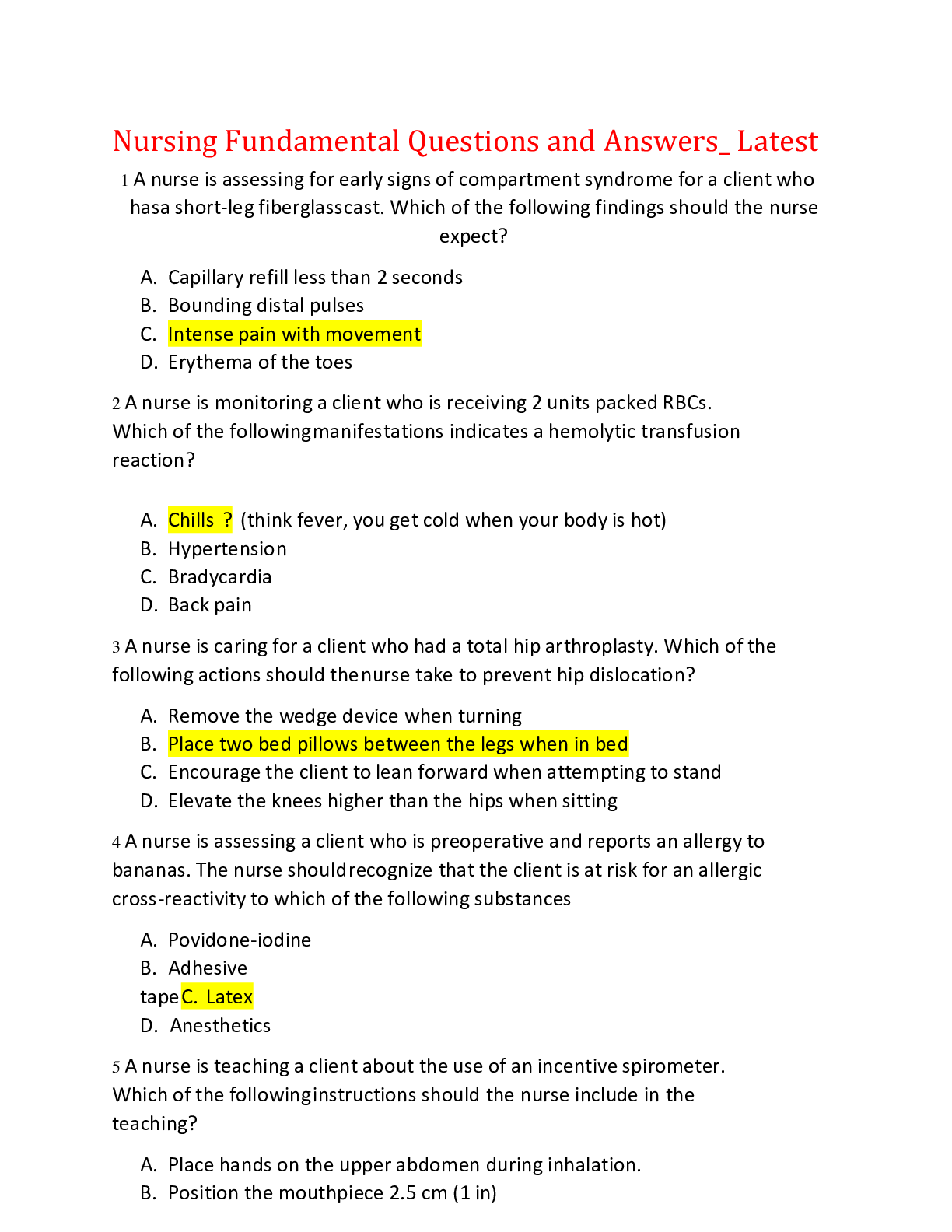


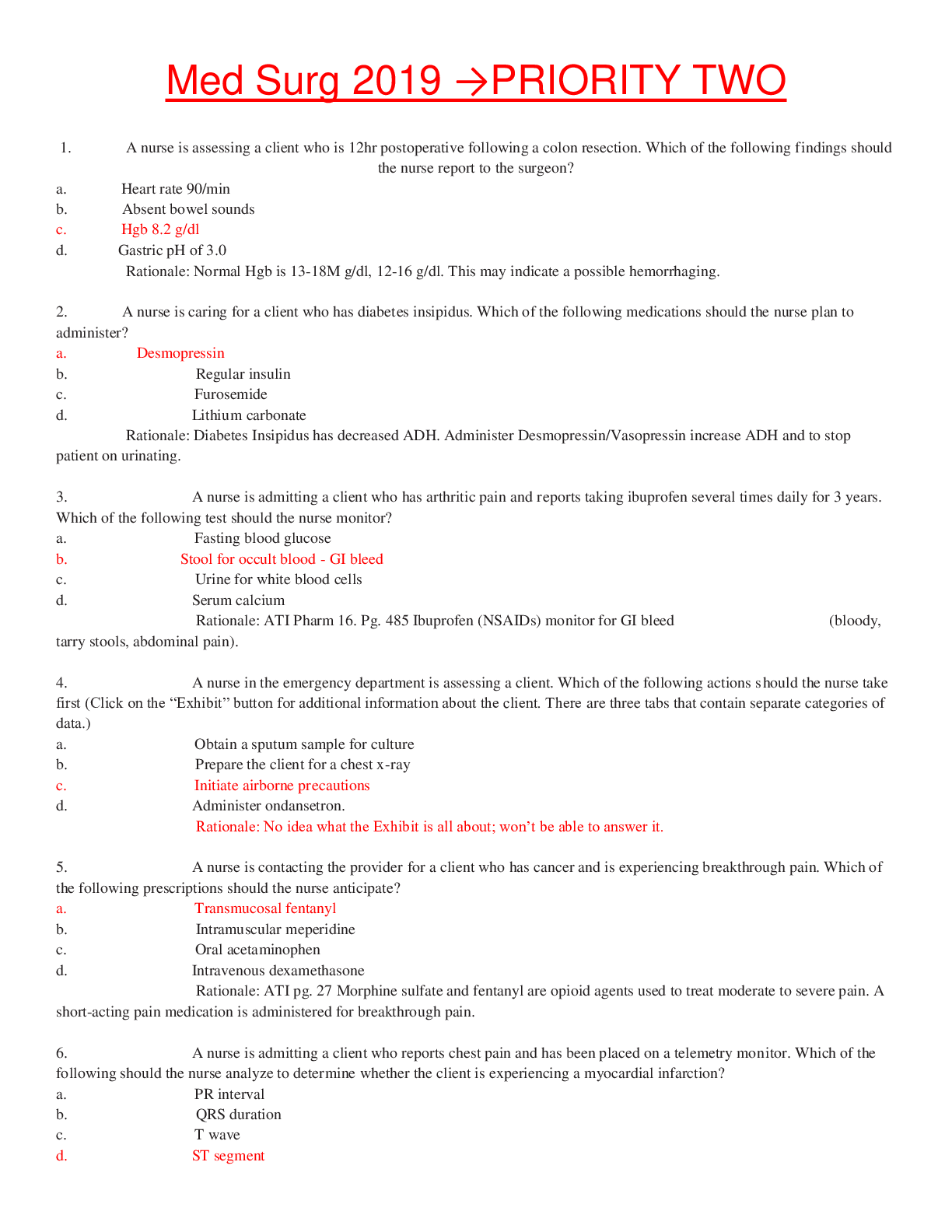
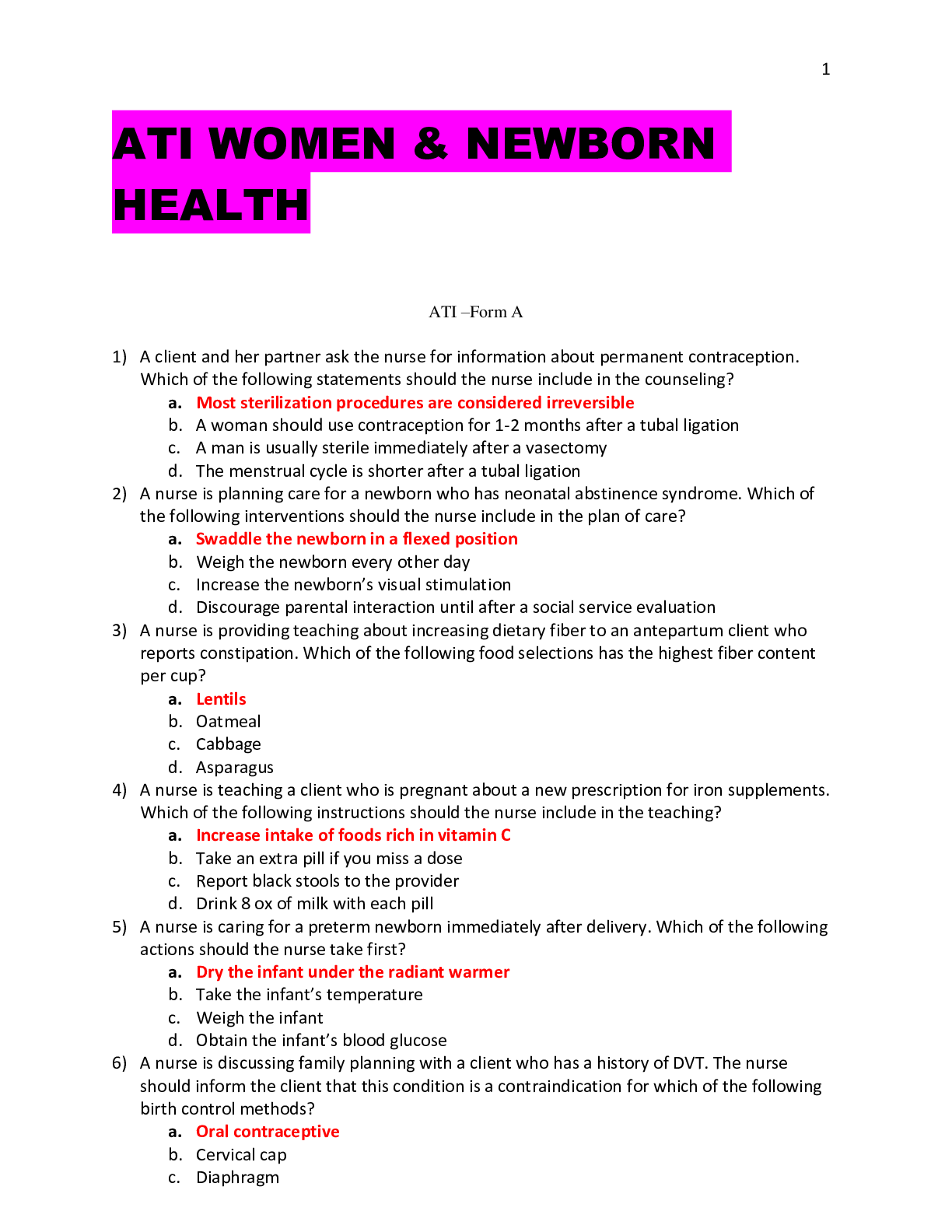


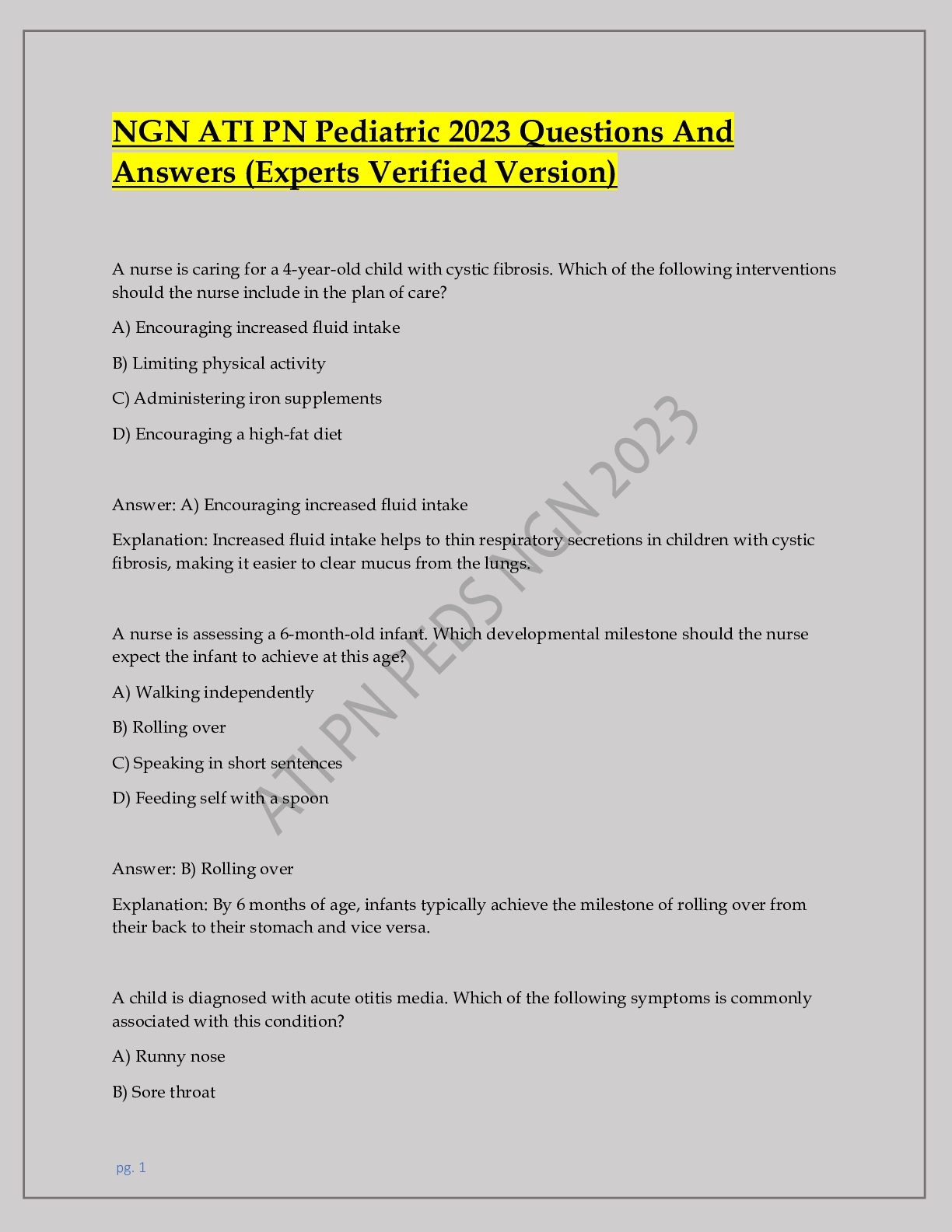

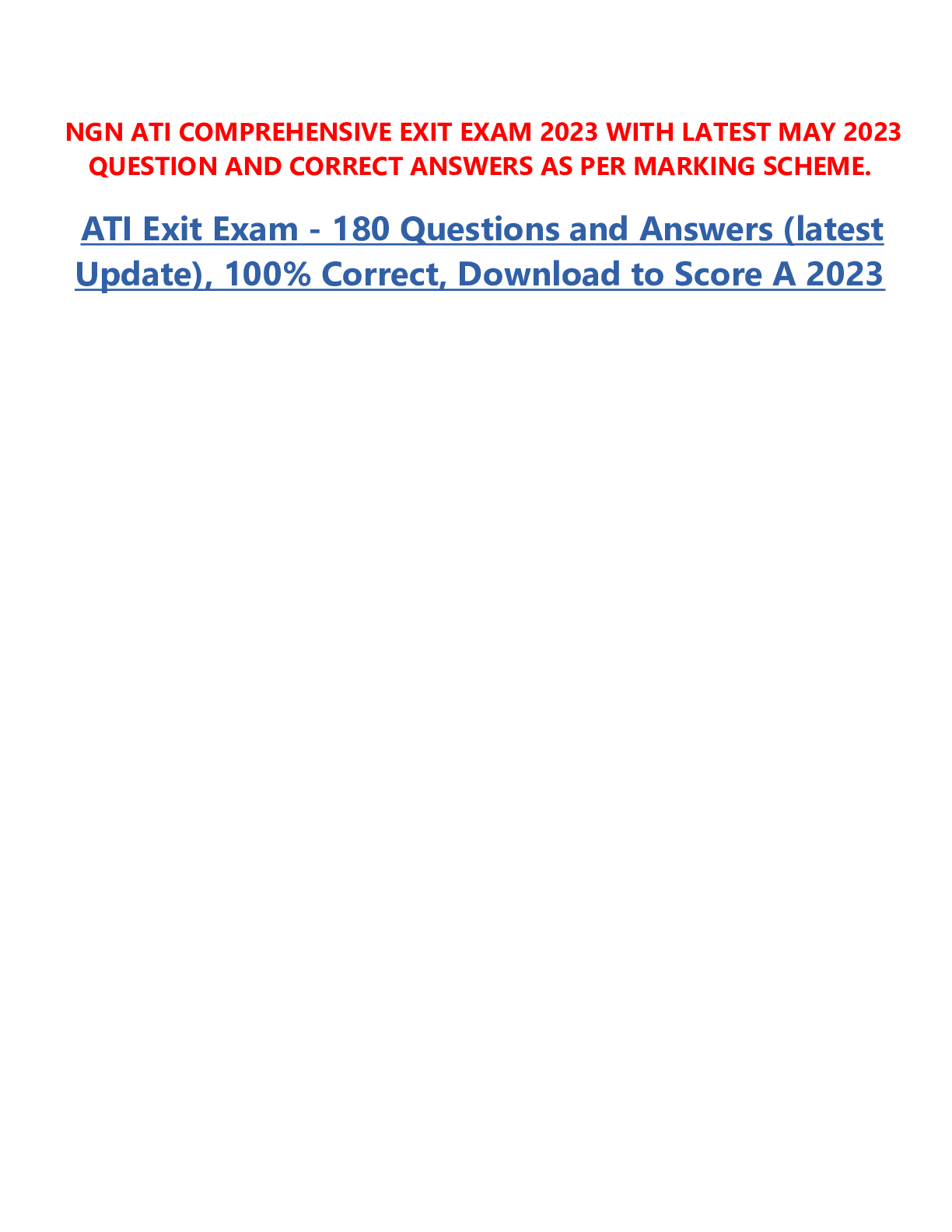
_Already Graded A.png)

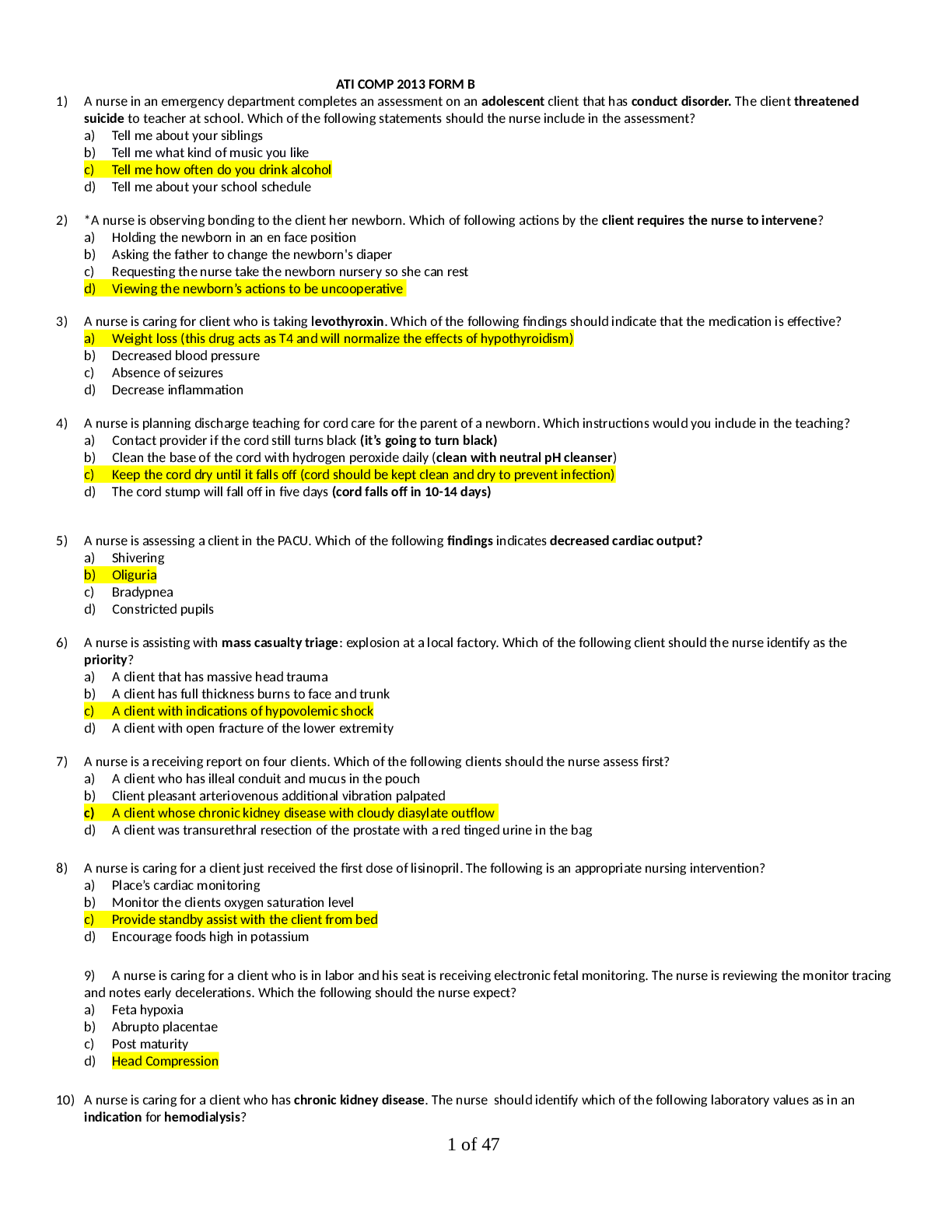
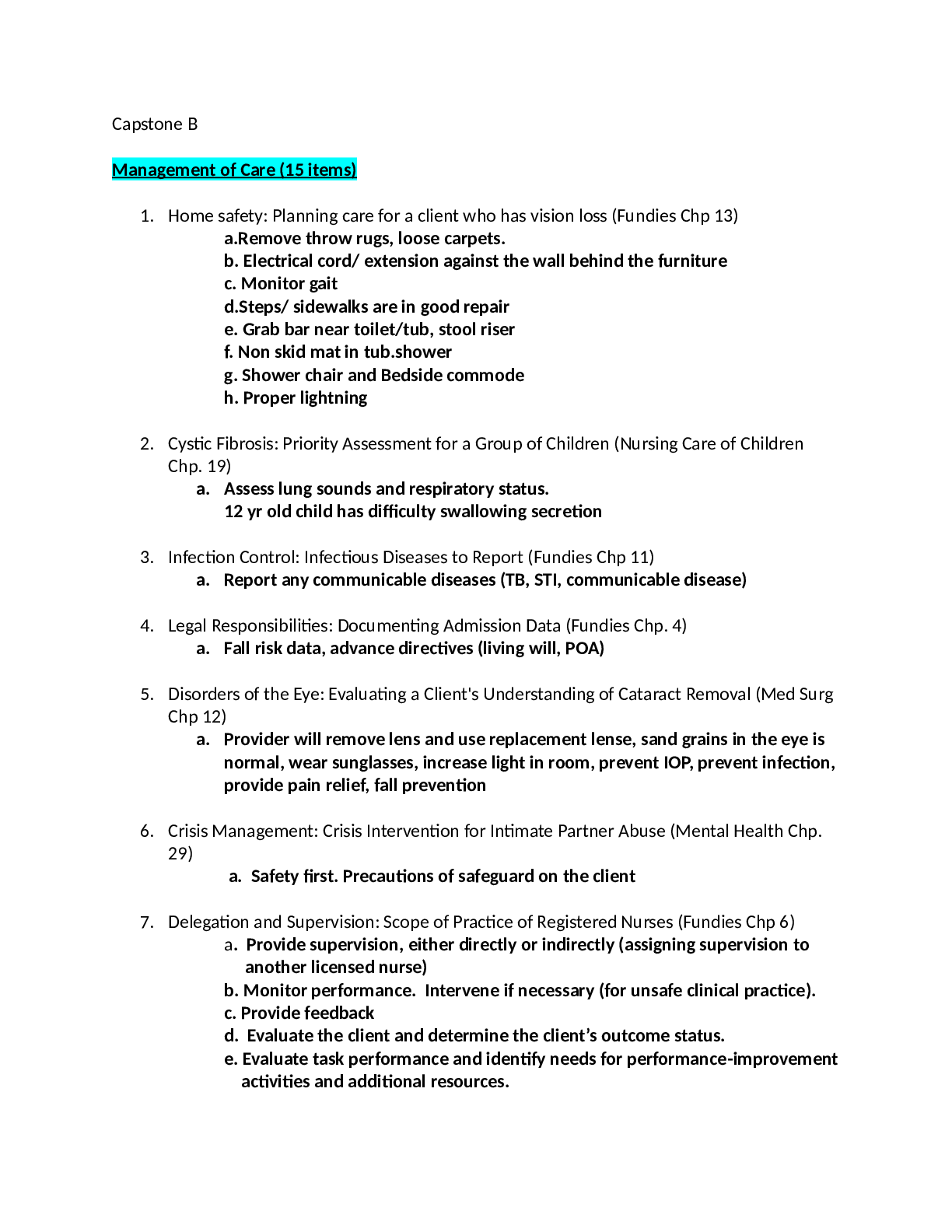
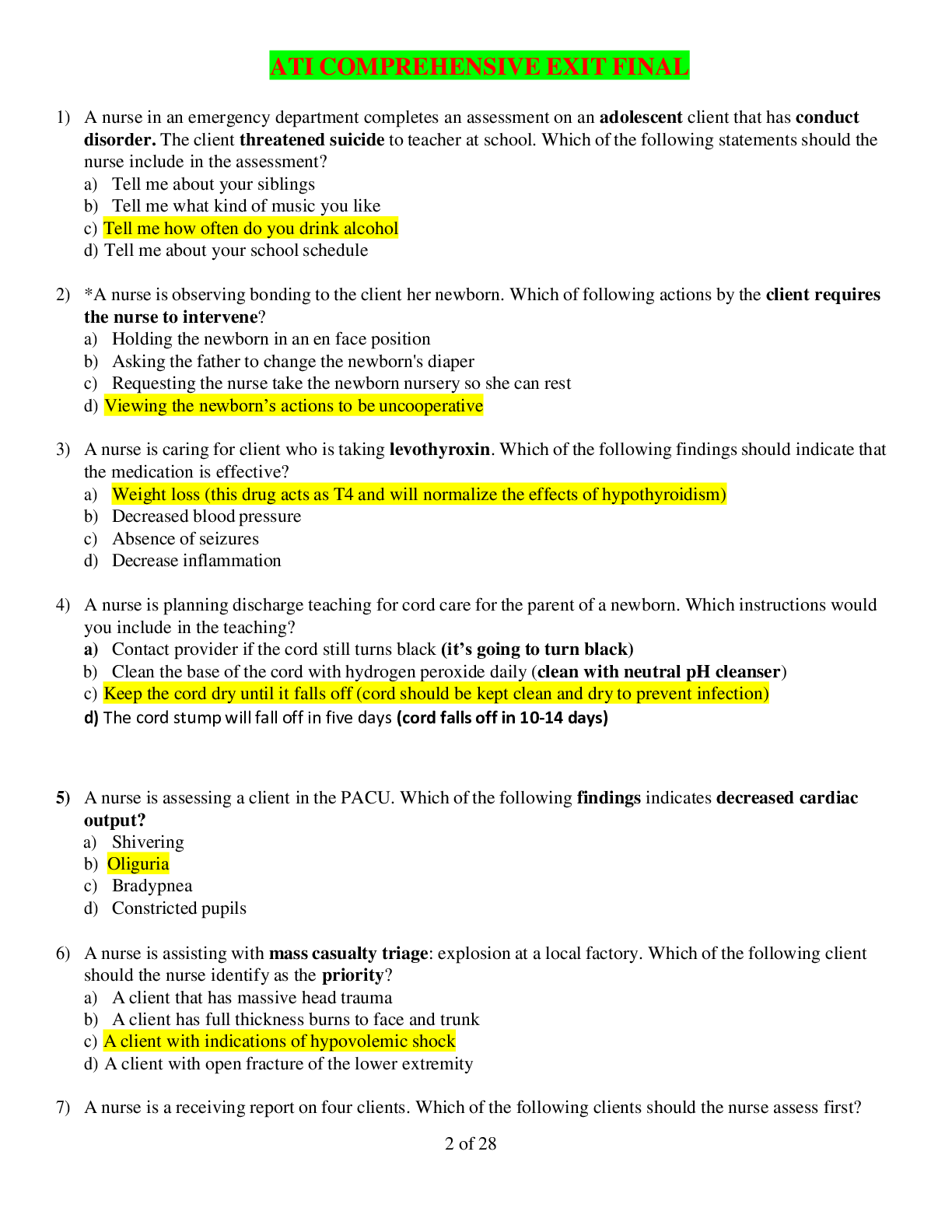
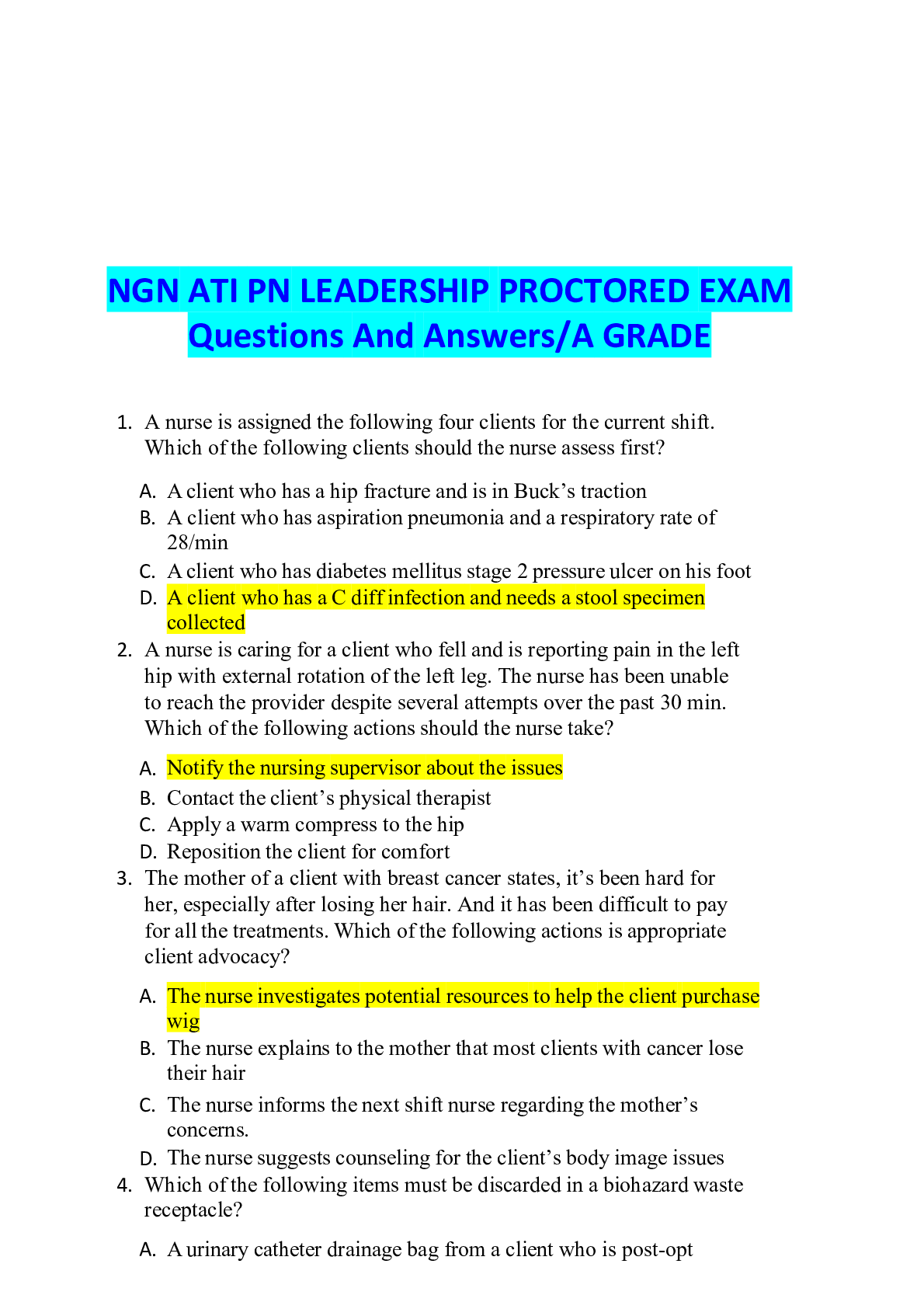
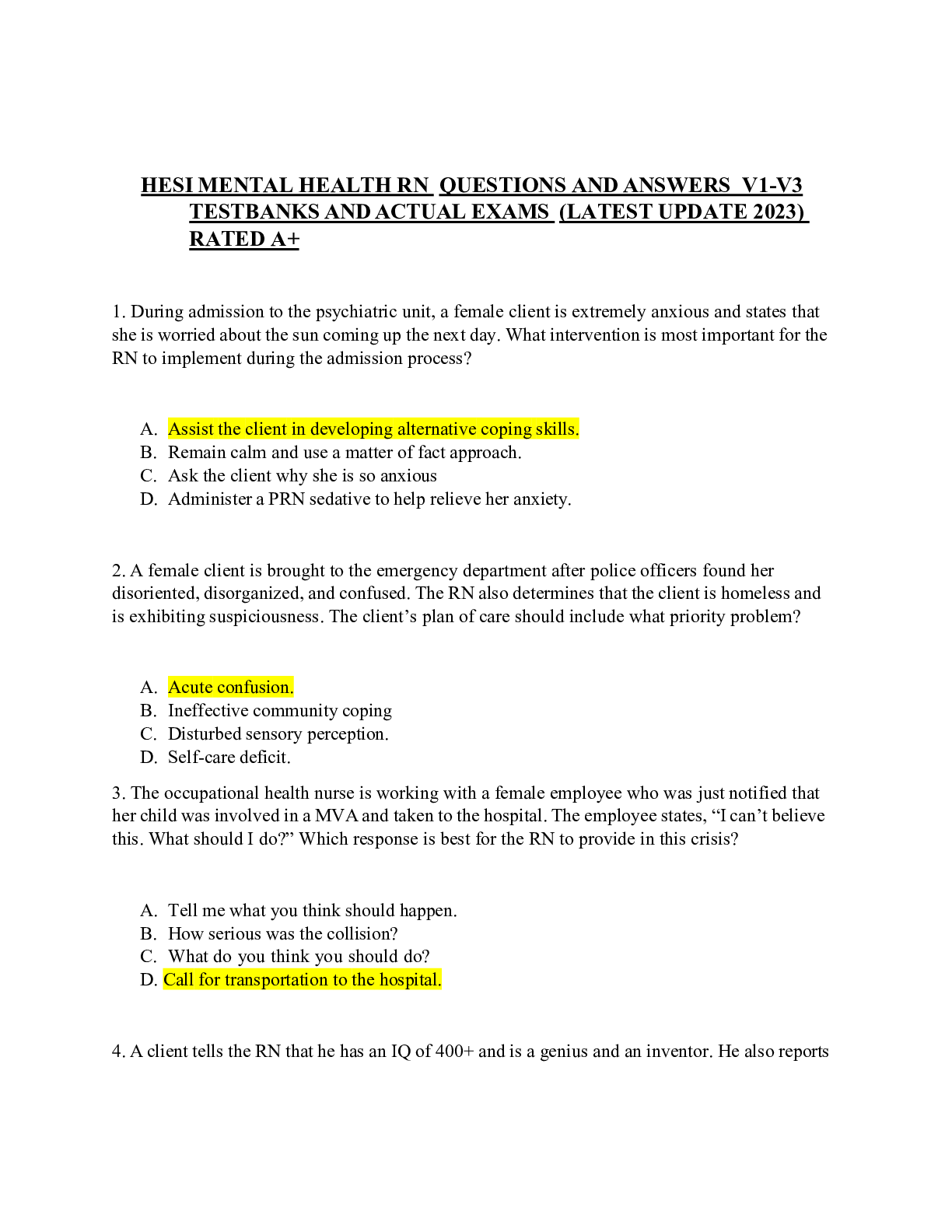




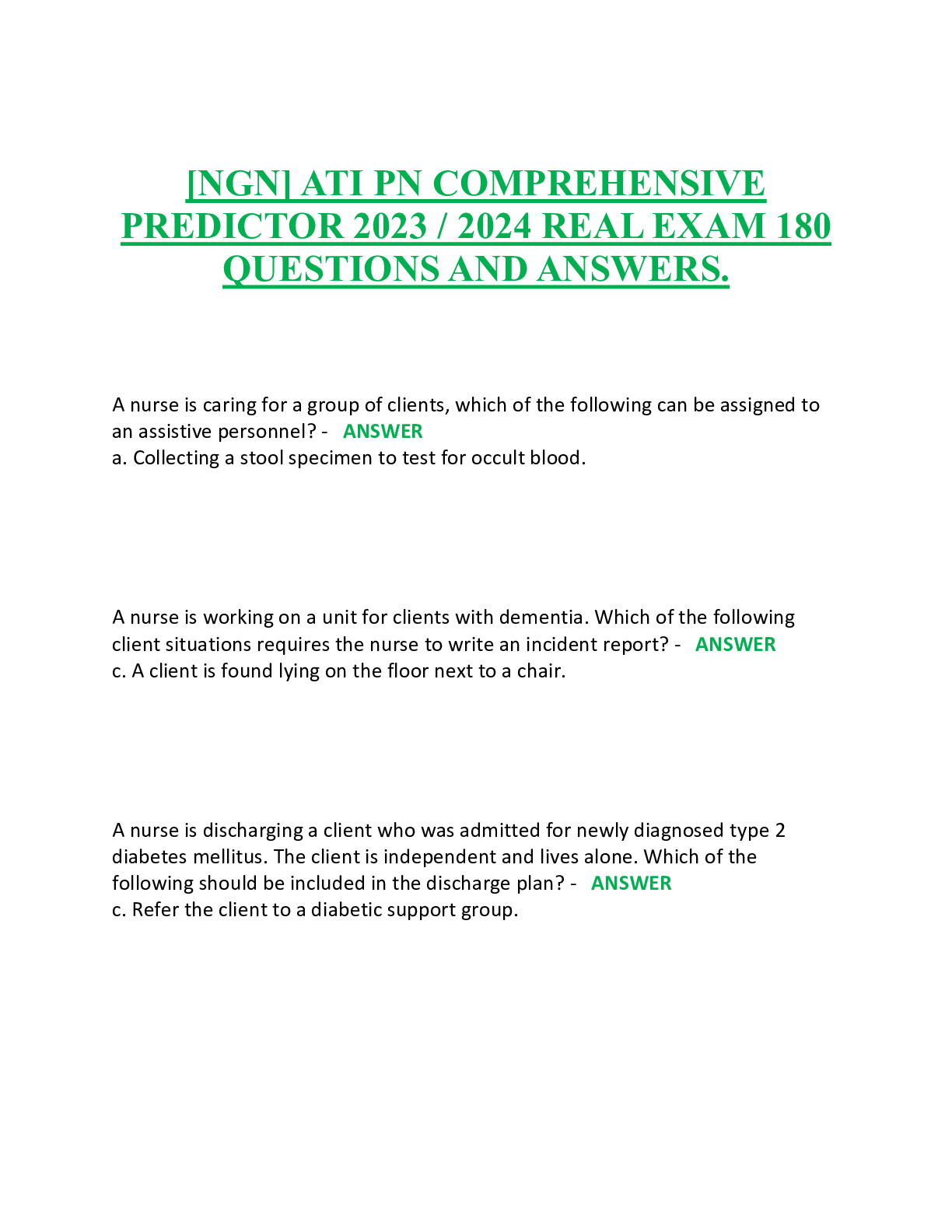
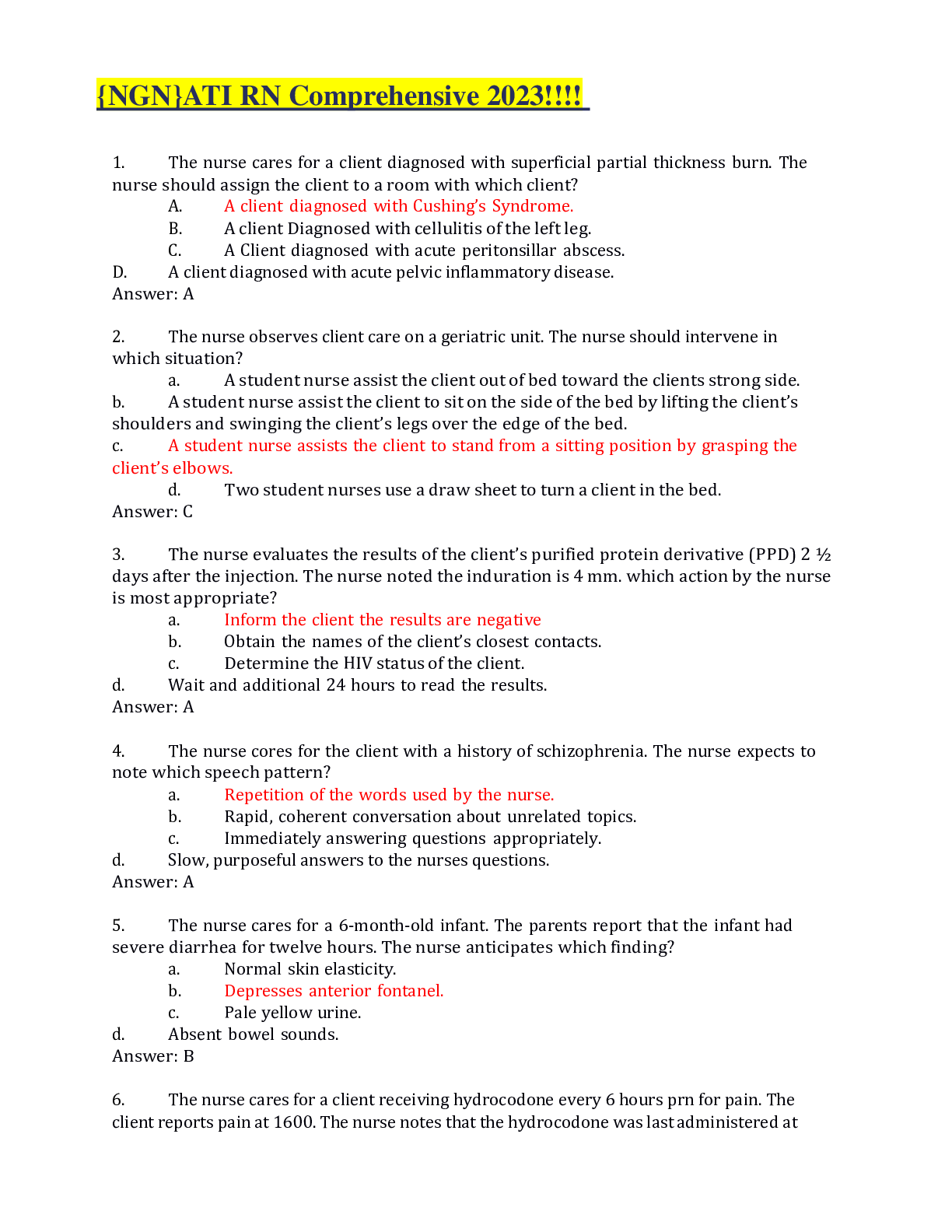
.png)
